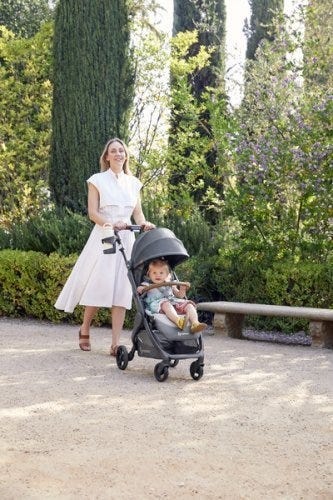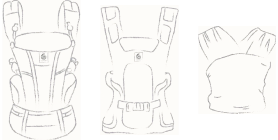"Are you mother’s little baby?…… Are yooouuu mother’s little baby?…… … Aaaare yooouuuu mother’s liiiiittle baaaaby?……" A mother is conversing with her little baby. She speaks with a high-pitched voice and her facial expressions are exaggerated, both in duration and in style. The baby is not yet sufficiently developed to respond in words to the mother’s repetitive and enthusiastic question, but somehow the mother perceives the baby to be fully capable of taking part in the conversation and she feels encouraged to go on. Those of us witnessing the “conversation” notice the joy and sheer fun emanating from the duo. We intuitively sense their mutual love and find it sweet. According to research described in the classic child development book “The First Relationship – Infant and Mother,” by pre-eminent psychologist, Daniel Stern, and according to a host of others, the vital role in baby brain development in these innocent play episodes is confirmed. These common “conversations” between mother and baby form or sculpt the extremely rapidly developing baby brain at a neurological level and equip the baby with the range of fundamental non-verbal skills which will become vital to the baby’s ability to cope with human life later on. This type of interaction is carried out in a very specific development period of the baby – the period from approximately 2-6 months, where the baby is intensely pre-occupied with the human face and actively seeks out social interactions with adults. Using “modern” filming techniques of the 1970’s, employing 16 millimeter film, Daniel Stern was the first scientist to notice the only universal language that exists, that of “Motherese.” Across the globe, women from all language groups are using this language to communicate with their babies: high-pitched voice, facial expressions that are drawn out and exaggerated, slowed down clear speech, slightly varying each sentence’s rhythm and duration. All these factors became apparent when the fast and brief conversations between mother and baby were slowed down with the help of the film camera, where recordings could be analyzed down to a 24th of a second. Essentially, what Daniel Stern realized was this: mothers, intuitively, and without any particular conscious hindsight, were training the baby to read the vast multitude of facial expressions that exist. Mothers were naturally performing small acts, or plays together with the baby, deliberately fixating each individual facial expression and drawing it out in time. This allowed the baby to recognize and record the communication. Mothers were simply improvising, changing facial expressions gradually, minutely, sometimes abruptly or grossly; all done in a completely spontaneous, spur-of-the–moment manner, providing whatever would maintain the baby’s interest and excitement for the interactive play taking place. Likewise with the verbal conversations, sentences were repeated again and again, as when learning a new language – which indeed is the case for a baby. The individual words were often pronounced quite slowly, or rather, they were drawn out, syllable for syllable, so that the baby again could manage to catch the words and really get a grasp for them and their sounds and rhythms. Viewing this approach from a pedagogical angle, all this training and learning was done in an atmosphere of play, excitement and fun. Maybe this is why teachers who are able to combine learning with excitement have always made the greatest impression on us later in life. Our first teacher (our mother) was that way. Daniel Stern realized something very important, not just about the mother (or any other emotionally engaged caregiver), but also about the baby. The baby is far from just a passive recipient in these play episodes. How is that possible - how does the baby manage to participate in the play and provide that essential feed-back that so spurs and excites the mother? A baby at about three months surely does not have particularly great control over its body, with the notable exception of its eyes (glance direction) and its neck musculature. Gradually, the intended social smile also sets in, in response to all the fun and games that the mother presents. Deliberately using its eyes and thus its glance, in combination with the direction of its face, the baby is able to completely control conversations with the mother. It became clear, when the fast conversations were slowed down to 24 pictures per second, that it was in fact the baby that often invited the conversations to take place by signaling with its glance, and the gleam in its eyes, and the direction of its face that it was ready. The mother would catch the clue and on went the fast and improvised play episode, with gradually increasing excitement building up in the baby as the result of masterfully performed facial choreography and verbal variations of the mother. When the excitement became too much for the baby, the baby itself actively broke off the contact by either turning its head, or averting eye contact. By repeating these play episodes again and again, each time with a slightly different accentuation or variation on the part of the mother, in as little as 4 months, the baby makes the miraculous transition from what appears to be a practically clueless baby to becoming the master of all the fundamental non-verbal skills required to conduct a proper conversation. The baby also learns fundamental lessons about being able to handle excitement or arousal, as it is called by psychologists. With even a remotely sufficiently sensitive mother, who respects the baby’s quite clear signals, the baby learns that it is capable of actively shutting out stimuli which are becoming a source of too much internal excitement. It does so by simply turning its head and/or closing its eyes. It also learns to regulate attention by intentionally maintaining eye contact, locking its glance to that of its parent or other caregiver. And it learns to read and interpret faces correctly. All these fundamental skills are indispensable for human life, vital precursors to a skillful conduct of verbal communication. Additionally, as later researchers have suggested, it seems that the neurological foundation for being able to experience joy is also stimulated by the baby being actively stimulated or pushed into high-arousal states (baby very excited in a positive sense) by the mother. It is as if the baby’s “joy muscle” is being created and sculpted by these joyful interactions. Much like a muscle needs to be used to grow or to avoid atrophy, the neurological circuits and neurotransmitters responsible for creating the sensation of joy in the human being need to be stimulated in this very important phase of the baby’s life. Isn’t that wonderful, how fun and development go so well together?
Literature: Daniel Stern. The First Relationship – Infant and Mother, Harvard University Press, 1977 Link: Talk To Your Baby Campaign, Transforming Lives. http://www.literacytrust.org.uk/talk_to_your_baby
Emotional Benefits of Getting Outside
Spending time in nature with your baby can strengthen the bond between you. The simple act of holding your baby close, feeling their warmth, and sharing new experiences together can create strong emotional connections. It’s also a wonderful way to reduce stress and improve your mood. When my littles were extra fussy, I’d take a walk around the neighborhood. Even though I don't live in an area with trails and surrounded by nature, simply behind outside changed everything. A little vitamin D does wonders!
Cognitive Development
Nature is a sensory wonderland for babies. The different sights, sounds, and smells can stimulate your baby’s senses and promote cognitive development. Watching leaves rustle, hearing birds chirp, and feeling the texture of a tree bark can all contribute to their learning and development.
All About Baby Carriers for Nature Adventures
Choosing the Right Baby Carrier
When it comes to selecting the best baby carrier for summer adventures, there are several options to consider.
Types of Baby Carriers:
- Wraps: Perfect for newborns, providing a snug and secure fit.
- Slings: Ideal for quick and easy use, offering good ventilation.
- Soft Structured Carriers: Versatile and comfortable for both parent and baby, suitable for longer trips.
Factors to Consider:
- Baby’s Age and Weight: Ensure the carrier is appropriate for your baby’s size and weight. For example, Ergobaby’s Embrace Newborn Carrier is perfect for the fourth trimester where baby is small and you’re looking for an easy way to stay close. As they grow, you’ll want to upgrade to an all-position carrier that’s meant for growing babies.
- Parent’s Comfort and Ergonomics: Look for carriers with padded shoulder straps and lumbar support if you’re planning on longer outings.
- Ease of Use: Choose a carrier that is easy to put on and take off.
- Climate and Breathability: Opt for carriers made of breathable fabrics to keep you and your baby cool in hot weather.
Safety Tips:
- Proper Positioning: Ensure your baby is seated correctly, with their legs in an "M" position and their head should be close enough to kiss.
- Checking for Wear and Tear: Regularly inspect your carrier for any signs of damage.
- Ensuring Adequate Support: Make sure the carrier provides proper support for your baby’s head and neck.
Exploring Nature with a Baby Carrier
Ideal Spots for a Nature Walk with Baby
- Parks and Gardens: Great for leisurely walks and picnics.
- Nature Trails and Forests: Perfect for more adventurous outings.
- Beaches and Lakesides: Wonderful for enjoying the water and sand, with the right carrier.
Activity Ideas
- Hiking: Enjoy a scenic hike with a hiking baby carrier that offers support and storage.
- Bird Watching: Use your carrier to keep your baby close while you explore and observe wildlife.
- Picnics: A carrier can free up your hands, making it easier to carry picnic supplies.


Advantages of Using Strollers for Nature Adventures


While baby carriers are fantastic for mobility and closeness, depending on the adventure of choice you might want to be a stroller along too.
There are a LOT of baby stroller options on the market. So we understand how confusing it can be to choose the one that’s right for your family. Not only are there a variety of brands, but a variety of strollers that serve different purposes.
There are a few types of strollers on the market:
- Full-sized stroller: This is typically the stroller parents thing of buying for all its versatility.
- Lightweight or umbrella stroller:These compact strollers are perfect for on-the-go adventures.
- Jogging stroller: Designed for parents who want to combine fitness with outdoor adventures.
- Double stroller: Designed for parents with multiple kids, especially twins.
- Car seat carrier: These strollers connect to a specific car seat. We don't typically recommend these as they can be unsafe for baby and uncomfortable for parents who are pushing.
Learn more about the types of strollers and which one would be best for you.
Benefits of Bringing a Stroller
- Storage Space for Gear: Ample room for carrying all your essentials like a diaper bag, beach toys and more.
- Shade and Weather Protection: Built-in canopies to shield your baby from the sun when they are lounging.
- Options: If you have more than one kid, you can stroll with one and carry the other. Or, if you’re getting warm or your little one is getting fussy, you can switch up their position from stroller to carrier or vice versa.
Safety Tips for Strollers
- Ensure your stroller is in good working condition. Make sure buckles are still buckling and that there are no rips or holes that could compromise your baby’s safety.
- Use sunshades or bug nets to protect your little one’s skin.
- Securing the baby properly: always buckle up your baby for safety even if you think they are old enough to go without the buckle.
Combining Baby Carriers and Strollers
For the ultimate flexibility, consider using both a baby carrier and a stroller on your outings.
Combining both options allows you to adapt to different situations. Use the carrier for more rugged trails and switch to the stroller for smoother paths or when your baby needs a nap.
Transition Tips
- Smooth Transitions: Plan stops where you can easily switch from carrier to stroller.
- Pack Light: Only bring essentials to make transitions easier.
Tips for a Successful Adventure
Planning Ahead
- Route Planning: Choose baby-friendly trails and parks. Check local mom groups or outdoor groups and get recommendations for the best outings for kids.
- Check Weather Conditions: Avoid extreme heat or unpredictable weather. Even with our most breathable carriers, when it’s hot, it’s hot. And having two bodies against each other in the heat will be naturally hot and sticky already.
- Packing Checklist: Include diapers, snacks, water, sunscreen, and a first-aid kit. These all-position carriers have storage pockets where you can fit some of the items easily!
- Stay Hydrated and Nourished: Pack healthy snacks to keep energy levels up and bring plenty of water for both you and baby.


Summer adventures with your baby are a wonderful way to create lasting memories and enjoy the beauty of nature together. From baby carriers to strollers, Ergobaby products are designed to provide comfort and ease for both you and your little one. So, gear up, get outside, and explore the world with your baby by your side.
Ready to embark on your own summer adventures? Check out Ergobaby’s range of baby carriers and strollers to find the perfect match for your family’s needs. Visit our website today and start planning your next outdoor excursion!


























